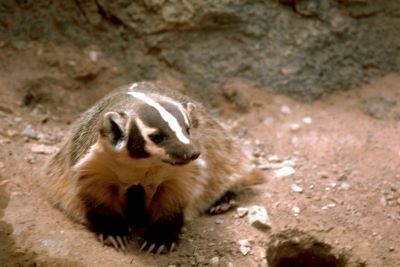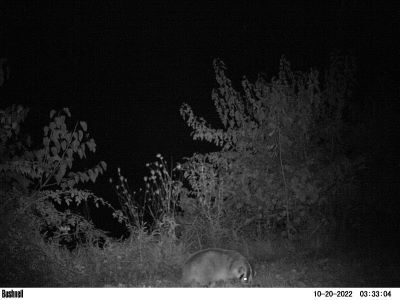
Good Natured: Badgers Aren't Only in Wisconsin
With a nod to the fast-approaching holidays, and with apologies to the late, great Mitch Miller, I'd like to present for you a new-for-2022 Christmas jingle:
Who's got a face that's striped with white?
Badger's got a face that's striped with white
Who comes around mostly at night?
Badger comes around mostly at night
Face with white, seen at night
Must be badger, must be badger
Must be badger, Taxidae taxus
See what we did here? Let's do one more verse:
Whose squat body is strong and sturdy?
Badger's squat body is strong and sturdy
Whose long claws frequently get dirty?
Badger's long claws frequently get dirty
Strong and sturdy, claws get dirty
Must be badger, must be badger…
I think you get the picture. But why are we singing about badgers at this time of year?
Well, other than the fact that a great nickname for this renowned burrower would be Sandy Claws, the American badger is one of those animals we should all keep on our radars. Due to overhunting, mainly by livestock owners looking to protect their animals, badgers had all but disappeared from Illinois by the late 1800s. But by the 1950s their numbers had rebounded and today they are present throughout the northern 2/3rds of our state, with preference shown for areas with sandy soils that are easy to excavate.
Now I know badgers don't have the widespread appeal that certain other mammals possess. For one thing, the references describe them as “solitary and defensive;" (that's “ornery" to you and me) with a reputation for ferocity. And for people with cattle and/or horses, the badgers' burrows are a concern, as they can trap and snap legs.
But if you need some help controlling populations of other diggers, like ground squirrels and woodchucks, you couldn't ask for a better ally.

Badgers are indisputably well-equipped for this role of fossorial carnivore, a designation that means they are predators that dig. Their low, muscular bodies feature feet with two keen adaptations: front claws that measure almost 2 in. in length; and partial webs between the toes, which function as scoops when it's time to make the dirt fly.
Their broad, flat heads have strong jaws outfitted with 34 sharp teeth—all the better to eat those aforementioned rodents, as well as voles and mice, and cottontails, insects and carrion. These dietary components are exactly the types of things that would get out of hand without some means of control, and the badger handles that task admirably.
Interestingly enough, coyotes and hawks can sometimes be found in the vicinity of a working badger, happy to help lest a rodent or rabbit get away.
We should also mention those burrows one more time. Nomadic by nature, badgers really don't stay in one place for very long, unless they're rearing young. The holes they dig primarily serve as temporary quarters, dug out in search of prey but then also acting as a nice out-of-the-way space to hang out and digest.
When prey is plentiful, badgers might dig holes at a rate of one a day, leaving a series of hollows that can then be repurposed as dens by other wildlife—like, say, snakes—that are less well equipped for digging.
With winter on the horizon, badgers' activity will take a seasonal drop. These animals don't hibernate, but their body temperature and heart rate drop and they retreat to a particularly deep burrow and wait until weather conditions improve.
When springtime comes, and you come across an area that has several large holes, dug steep and deep, you might want to keep this song in mind…
Who this spring may come our way?
Badger this spring may come our way
Digging holes going after prey
Badger digs holes to capture prey
Badger prey, come our way
Face with white, seen at night
Strong and sturdy, claws get dirty
Must be badger, must be badger
Must be badger, Taxidae taxus!
Pam Otto is the outreach ambassador for the St. Charles Park District. She can be reached at potto@stcparks.org.

